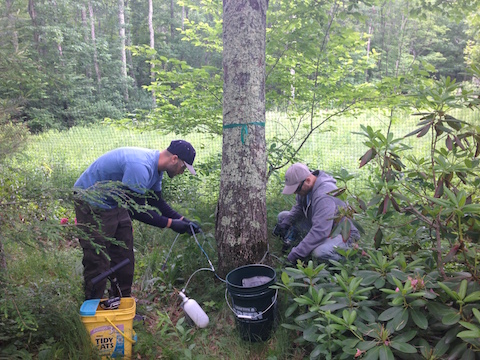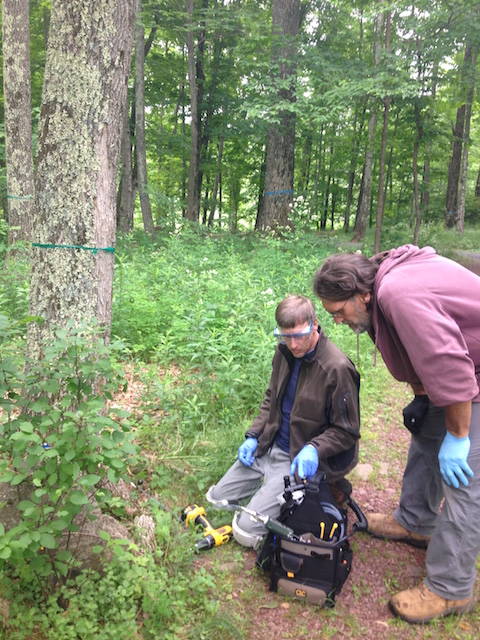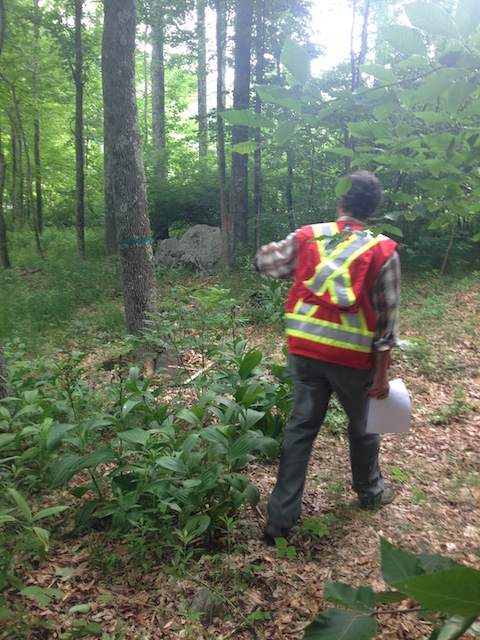Many trees along Route 23C leading up to the Mountain Top Arboretum in the Greene County village of Tannersville don't stand a chance. They are ash trees, victims of the ongoing Catskills invasion by the emerald ash borer, and they loom over the road like skeletons pinned against the sky.
But turn right onto Maude Adams Road into the natural sanctuary on the mountaintop and here, in an experimental strategy, volunteers are giving a large stand of ash trees a chance to defend itself.
Begun last year, the research project plans to treat about 160 ash trees on several acres with a systemic insecticide that protects ash trees against the non-native emerald ash borer, which researchers say is the most destructive forest insect to invade the U.S.
The insecticide is emamectin benzoate, which many U.S. communities are using but on a small landscape scale, such as one tree at a private home or five trees along a street.
The arboretum project, however, is testing the pesticide’s efficacy on a wide-area scale – on three acres in the arboretum’s seven-acre Woodland Walk. It will not treat all 160 trees at once, but in batches annually to reduce the amount of insecticide and labor while still maintaining a chemical barrier.

Above: Arborists inject an ash tree with insecticide as part of the arboretum's experimental strategy to save its stand from the emerald ash borer. Photo by Laney Salisbury.
The project is the first to test the insecticide on this scale in New York state, said study leader Mark Whitmore, a forest entomologist at Cornell University’s Department of Natural Resources.
If successful, the experiment would not only help the arboretum -- where ash trees have managed to thrive in a rigorous climate 2,400 feet above sea level until the borer appeared -- but it will provide a cost-effective solution for other communities confronting infestations in parks and communal areas that have many ash trees.
“It’s going to be a big upheaval” if all the ash trees die in the Woodland Walk, said Joan Kutcher, the executive director of the 179-acre arboretum. “Our hope is to keep alive some beautiful, healthy specimens so that after the infestation passes there will be a seed bank of local ash trees.”
Ash trees, which make up 30 percent of the trees in some areas of the woods at the arboretum, are a prominent feature in the Woodland Walk and its ecosystem of native flora that includes mountain laurel, trillium and Jack-in-the pulpit.
The ash borer, which was first detected in the Catskills region in 2010, was confirmed to have killed ash trees in the arboretum’s East Meadow area in October 2014. The long-term project in the fenced-in Woodland Walk began in Spring 2014.
Whitmore and Kutcher both expressed surprise at how the quickly the infestation had spread up the mountain even though they’d been monitoring it and had prepared.
Protecting an ash forest
On one recent overcast spring morning, Whitmore walked around the Woodland Walk to evaluate the trees and begin the second year of injections with emamectin benzoate, which can remain effective up to three years.
Whitmore said he plans to treat the trees in batches of 50 to 60 – or one-third -- annually. When the last third is treated next year, the process is expected to repeat for at least nine years.
“By the end of today, two-thirds of the stand will be protected,” said Whitmore, standing next to a large, healthy ash tree with a green ribbon around its trunk on Thursday, June 18. The green ribbon marked the tree for treatment later that day. Trees with blue ribbons were treated last spring.

Above: Vern Rist and Phillip Lewis look over a new, faster pump to inject an ash tree with emamectin benzine in the arboretum's Woodland Walk. The tree with the blue ribbon was treated last year. Photo by Laney Salisbury.
The idea to treat ash trees on a wide-area scale came from a computer model by Michigan State University researchers who simulated the use of emamectin benzoate in a theoretical suburban neighborhood where ash comprise 20 to 30 percent of the urban forest canopy, a percentage similar to many U.S. municipalities.
The 320-block hypothetical neighborhood has 2,314 ash trees. At its center, researchers placed a pile of hypothetical ash firewood – from which emerged 400 adult emerald ash borers.
In the computer model, when no insecticide was used, the borer population grew and expanded, and the rate at which ash trees in the theoretical neighborhood died accelerated. By the seventh year, 58 percent of the trees in the neighborhood were gone. By the ninth year, it was 97 percent, according to the model.
However, when researchers plugged in various scenarios in which a different percentage of the 2,314 trees were treated at one time, the survival rate and economic cost improved. The model indicated that when 20 percent of the ash trees were treated annually, 99.5 percent of the ash trees remained alive after 10 years.
“Costs for removing and replacing declining ash trees were dramatically higher than costs associated with treating ash trees with the emamectin benzoate insecticide,” reported the research paper on the model.
In addition, the theoretical neighborhood got to keep the trees – along with the aesthetic, health and environmental benefits they provide.
“We can do something [against the ash borer],” Whitmore said, standing next to another (real) ash in the Woodland Walk with a green ribbon around its trunk. The tree also had a red ribbon, indicating that last year, Whitmore had found some holes made by woodpeckers, a sign the tree was already host to a population of emerald ash borers.
The tree now had modest dieback at the crown. “This tree can still be treated,” he said, adding that if more than 50 percent of the canopy had been killed off by the borer it would have been too late to treat it.
"One bite on a leaf and it dies"
Whitmore walked through the stand with volunteer contributor Vern Rist, owner of Saugerties-based Healthy Trees, which is licensed to administer the pesticide. Phillip Lewis, a research entomologist with the United States Department of Agriculture Animal and Plant Health Inspection Service, is also volunteering his expertise for the project.
“We are picking the nicest trees and getting some down at the perimeter to try to get the insects as they are coming in,” said Rist.
The insecticide, which has so far been donated to the arboretum project by Arborjet Inc., is injected into holes drilled into the base of the trunk. The injections can take a few seconds to a few minutes, depending on the tree and temperature. Once injected, it takes about two to three weeks for the tree to pull the insecticide up into the leaves.
The scientists aim to time the injections to when adult emerald ash borers emerge from the bark to feed on the leaves. Adult females, which need to feed on the leaves at least 14 days longer than males to develop their ovaries to lay eggs, are particular targets.
“One bite on a leaf and it dies,” said Whitmore.

Above: Mark Whitmore, who is conducting the study, walks amid the ash in the stand with his data sheet evaluating trees marked for treatment. Photo by Laney Salisbury.
Whitmore said he decided to treat the trees in batches in part because the Michigan study assumes a higher mortality rate among the egg-laying females in the hypothetical neighborhood. Treating one-third of the trees at a time will cover enough of the woods that any bug has a good chance of feeding on the leaves.
While the study is expected to “evolve” as it progresses, Whitmore said the goal is to treat the trees long enough until the local emerald ash borer populations exhaust the ash food supply and decrease substantially.
Once the pressure has subsided, the trees can be managed with less frequent treatments, he said, adding that healthy ash trees can survive one or two attacks by the borer.
But when that population collapse will occur is still unknown.
“I don’t know how long EAB is going to remain in the area,” said Whitmore. “Out in the midwest it appears to be about 12 years, so the study in my mind is going to be ongoing … it’s something I feel keenly about and I want to follow it through to success.”
Previous coverage:
"Dying and dying quickly:" Ash trees succumb to emerald ash borer in Catskills, June 5, 2015















